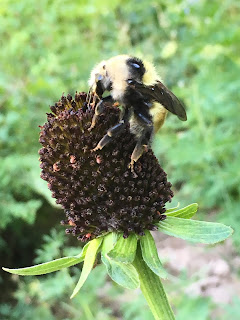Everyone in Utah knows that the early Mormon pioneers learned to dig Sego Lily bulbs from the Indians, in order to survive during the first years in Utah. It seems that few people have actually looked up those references, because most of them say the Indians taught them about
Thistle roots at the same time they taught them about Sego Lily bulbs. Even though Thistle roots are much more common, and very much easier to dig up, Sego Lily has become the state flower, while Thistles are an undesirable weed. I wonder which the pioneers really ate more of?
Most common thistles are members of either the
Circium genus or the
Carduum genus, but there is a whole tribe, called
Cynareae, which contains the extended thistle family, including star thistles, sow thistles, and other thistle-like plants. Thistles tend to be biennial, growing a low rosette of leaves the first year in order to store up energy in the root and then using that energy during the second year to send up a large flowing seed stalk. This all means you want to dig the root when the plant is in the rosette stage, and the biggest roots will be found either in the fall or in the early spring. After the seed stalk starts forming, the root is likely to be woody and inedible. (If you have ever let carrots overwinter in your garden and tried eating them the second year after the seed stalk forms, you will know what I mean.) Since plant taxonomy relies mainly on the flower to distinguish between species, this also means you might not be able to identify the exact species you are digging up. And this is not of much concern, since most common thistles are culinarily interchangeable, along with several genuses of similarly thistle-y plants, such as
Cnicus (blessed thistle),
Silybum (milk thistle), and
Onopordum (scotch thistle). Most of the other genuses in the tribe look less like the classic thistle or do not grow in this area.
Thistle rosettes are easy to find and not very difficult to dig up, especially if you are wearing gloves. If you are not wearing gloves, just dig up the rosette as much as you can, grab it by the root, and cut off the leaves.
I experimented first with the roots of thistle, since it was spring and while the rosettes are common, the tall stalks are not. While digging them up, I often only got the top part of the root, leaving the long thin lower portion of the taproot still in the ground. I found out this was actually a good thing because those thinner parts of the root are too tough to eat, even after cooking. Raw, the roots were very tough, but could be eaten if cut into thin enough pieces. The taste was fairly bland, not bitter at all, but the toughness made me want to cook it.
After cooking for about 20 minutes, the roots had softened up and were edible. The large roots softened the most, and could be eaten like a carrot by biting off pieces. Middle sized roots were still rather fibrous, but could be eaten easily enough after chopping into pieces. Small roots were still too tough and woody to eat at all. The flavor was good enough although not exceptional. Perhaps somewhere between the taste of spinach and cauliflower, with no bitterness and even tending toward the sweet side. I noticed that the crown of the root, where the leaves join together, is especially tender and tastes better too.
Another way to enjoy thistles, is to eat the central vein of the leaf. The leaf must be picked from the plant, and the sides of the leaf with all the spines stripped off. This is fairly easy to do with gloves or with a knife, and less easy but possible with bare hands. The taste is a lot like celery, with a little bit of bitterness, but it still makes a good snack while on the trail. The smooth-skinned thistles are much better for this than the ones with a lot of hairs.




